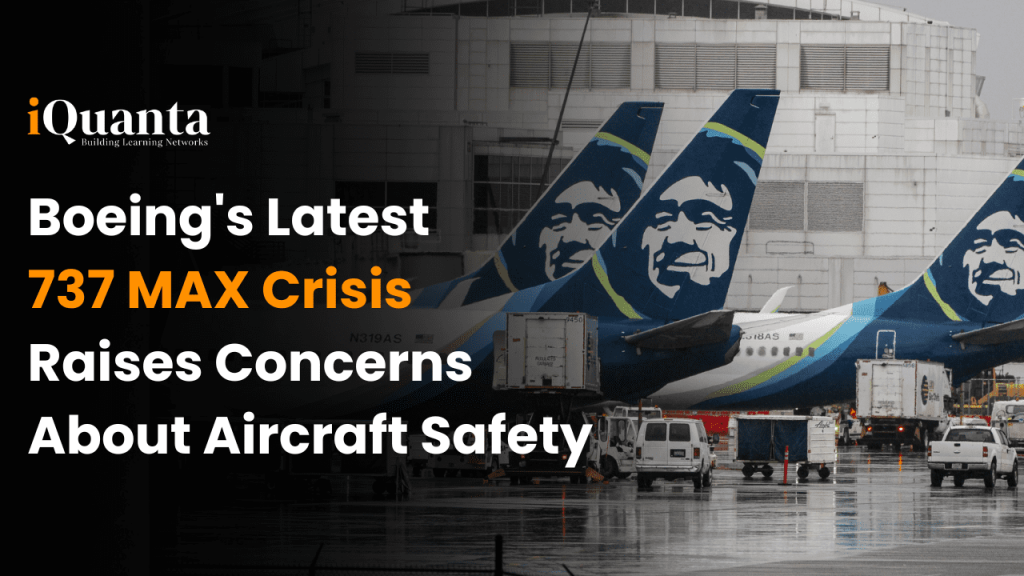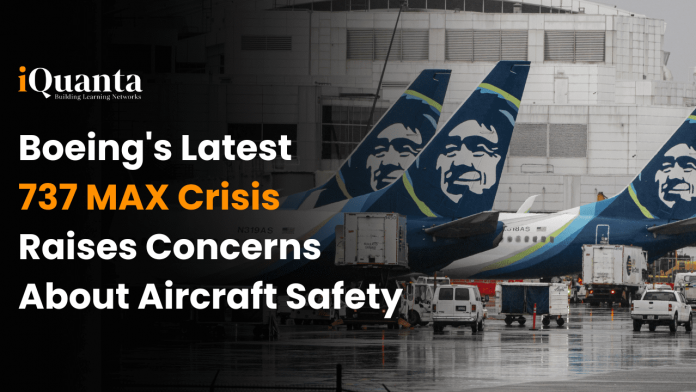
Genre : Business
Boeing’s 737 MAX 9 aircraft are the subject of a fresh crisis as United Airlines and Alaska Airlines find loose parts on several grounded aircraft, raising questions about the manufacturing process. Following an incident where a panel blew off an Alaska Airlines flight, the Federal Aviation Administration (FAA) grounded 171 MAX 9 aircraft and ordered immediate safety inspections. This development compounds the difficulties Boeing has faced since the 737 MAX family was grounded in 2019 following two deadly crashes.

Concerns Escalate with Loose Parts Discovery
United Airlines and Alaska Airlines report finding loose parts on their grounded MAX 9 aircraft during preliminary inspections. Alaska Airlines finds “loose hardware,” and United Airlines finds bolts on multiple panels that need to be tightened. Concerns regarding the manufacturing procedure and quality assurance of Boeing’s best-selling jet family are brought up by the revelation.
Impact on Airlines and Passengers
Concerns regarding the safety of the MAX 9 aircraft are increasing among passengers in light of the finding of loose bolts and ongoing conversations between Boeing, the FAA, and airlines. Even though the situation only affects a few carriers, given the increased sensitivity surrounding aviation safety, it could have an effect on Boeing’s reputation.
Inspection Challenges and Revised Guidelines
With FAA approval pending, Boeing is anticipated to amend inspection guidelines provided to airlines. Nearly ten United Airlines aircraft were discovered to have loose bolts, highlighting the importance of careful inspections. Precise inspection guidelines are being worked on by the FAA, Boeing, and airlines; any delays could put further strain on Boeing, which has already experienced production problems since the 2019 grounding.
Quality Control Issues and Fleet Problem
John Cox, an expert in aircraft safety, emphasizes that the loose parts problem makes it a fleet issue and highlights a quality control challenge for Boeing. The event forces a review of the manufacturing and maintenance logs, with an emphasis on resolving problems related to the door plug’s installation, specifically those bolts that require more tightening.
Financial Impact and Market Reaction
Boeing’s stock fell 8% as soon as the loose parts problem was made public. The financial impact extends beyond Boeing, as Spirit AeroSystems, a supplier involved in the manufacturing process, witnessed an 11% decline in its shares. Amidst mounting uncertainties, the situation puts additional financial strain on Boeing and its suppliers.
Flight Cancellations and Operational Disruptions
United Airlines and Alaska Airlines both have to cancel flights due to the grounded MAX 9. The FAA requires more thorough inspections, which include examinations of the fasteners, door components, and exit plugs on the left and right cabin doors. Multiple flights experience disruptions and cancellations due to the unpredictable timing of inspections.
Safety Investigation and Recovery of Panel
Examination of the incident’s manufacturing and maintenance records is part of the ongoing investigations. A Portland schoolteacher discovers the recovered panel—which blew off during the Alaska Airlines flight—in the back yard. The incident has led to calls for retrofitting current airplanes with recorders that can capture larger amounts of data in order to improve safety protocols.
Global Impact and Grounding of Affected Jets
The impact extends globally, with Turkish Airlines, Copa Airlines, and AeroMexico grounding affected MAX 9 jets. As a precaution, Indonesia also stopped using three jets that are not covered by the FAA order. The extensive grounding is a reflection of worries about the 737 MAX 9’s safety that are being expressed globally.
Serious questions concerning the safety and manufacturing processes of Boeing’s best-selling jet family are raised by the company’s most recent 737 MAX 9 crisis. The severity of the situation is highlighted by the discovery of loose parts, flight cancellations, and worldwide grounding. Boeing must work to win back the trust of regulators, airlines, and travellers as the investigations continue. The incident worsens the problems that have persisted since the 2019 grounding and jeopardizes Boeing’s financial stability and reputation. To guarantee the long-term safety and dependability of its aircraft, the aerospace behemoth needs to take immediate action on these problems.
AIR INDIA-VISTARA MERGER
There have been repercussions in the aviation sector following the proposed merger of two significant Indian airlines, Vistara and Air India. Full-service carrier Vistara’s proposed merger with Air India is expected to be completed by mid-2025, and all legal approvals for the transaction are anticipated by the middle of this year, a top executive said on Monday.
Asserting that it is going to be a “merger for growth”, Vistara CEO Vinod Kannan said it would look to take the airline’s consumer-focussed services, operational excellence and staff into the merged entity.
The Tata Group announced in November 2022 that Vistara and Air India will merge. As part of the agreement, Singapore Airlines will also buy a 25.1% share in Air India. With 67 aircraft in its fleet and about 320 daily flights, Vistara is a joint venture between Tatas and Singapore Airlines. By April of this year, it hopes to have added three additional aircraft, one of which will be a Boeing 787, bringing its fleet size to 70. The airline is doing better financially than it did the previous year, Kannan said during a conference. The airline will complete nine years of existence on January 9.
“We broke even in the last quarter of last year (2022-23). From October 2022 to July 2023, we were in the black but then like for most other airlines, July, August, September and October were the weakest months, and we had to take some losses there… December has been a very strong month,” he said.
According to Kannan, the operational merger is likely to occur by early to mid-2019, while the legal clearances are expected by the middle of 2024. He added that the current quarter, which ends in March, is when all competition approvals are anticipated. The planned merger was approved by the Competition Commission of India (CCI) on September 1, 2023.
At the end of 2023, about 35 per cent of Vistara’s capacity was deployed on international routes and the remaining 65 per cent on domestic routes.
“There were 16 per cent more flights from December 2022 to December 2023. That is in terms of departures,” Kannan said and added that the airline will not be operating flights to the US and will focus on Europe and Southeast Asia. About the last nine years, Kannan said one of the biggest learnings is that scale matters. “We have matured over time; trying to make sure customer is at the centre of everything… we hope that in time we will be able to carry this on to Air India as well,” he added.
“We want to make sure that everyone in Vistara does have a role (in the merged entity),” the CEO of Vistara stated about the merger process. The purpose of the merger is expansion, not cost-cutting or efficiency. Furthermore, he stated that the airline has been able to manage with its own cash flow and that no further funding infusion from the owners is required.
Kannan emphasized that there will always be a need for human intelligence because some scenarios cannot be handled by bots. In the meanwhile, Vistara wants to deploy virtual reality and augmented reality technology for specific staff training activities.
The merger is driven by the following factors:
- Synergy and Cost Optimization: Streamlining routes, maintenance facilities, and administrative overhead would be possible with the combination of operations. This might result in large cost savings, increasing the combined company’s competitiveness in the very competitive Indian aviation sector.
- Improved Network and Fleet: By expanding the network, travellers would have access to more destinations and a greater range of travel alternatives. Furthermore, the amalgamated fleet would grant entry to an extensive array of aircraft, accommodating distinct passenger segments and routes.
- Market Share and Brand Consolidation: Despite its financial struggles, Air India, the country’s flag airline, continues to honour India’s aviation heritage. In contrast, Vistara is a relatively new airline that is well-known for its high-end offerings and distinctive brand. The goal of the merger is to combine the advantages of both airlines to build a stronger company with a bigger market share.

